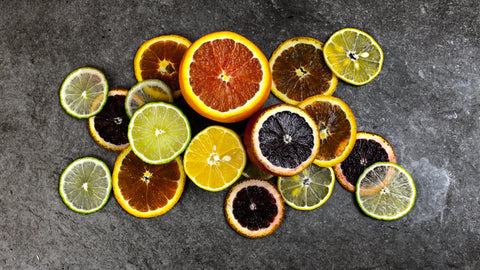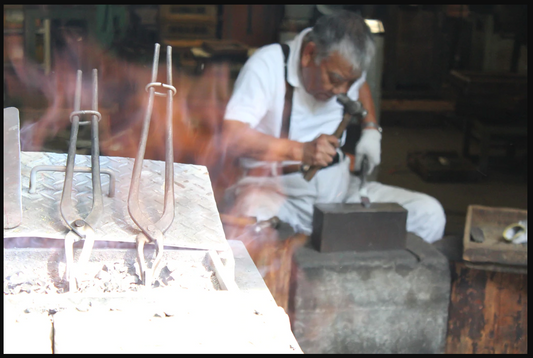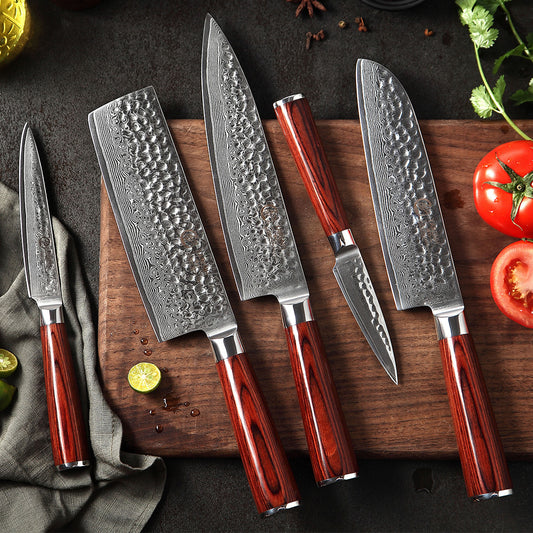The secret of the high cutting performance and quality of Japanese knives is much related to the fine blade steel. We would like to introduce popular and major blade steel materials with the detailed and efficient information. It may be a bit complicated
High quality steel alone does not guarantee a high quality knife blade, as the microstructure of the steel can be significantly affected by the forging techniques, forging temperatures and heat treatment methods used during its manufacture. Each of the various cutlery steels also has different characteristics, so they might not be suitable for a particular blade geometry or cutting task. One secret behind the sharpness and cutting performance of Japanese knives lies in the traditional forging and heat treatment techniques used by the blade smiths, many of these techniques have been in use for several hundred years and were originally developed by Japanese sword smiths. Similarly, the geometry of the blades that they make are typically based upon traditional forms which have stood the test of time, in some cases for several hundred years. The knives we sell are made by experienced blade smiths and craftsmen who understand how to extract the best characteristics from the steels they work with and also which forging techniques, heat treatment procedures and blade geometries are suitable for each of the different types of knife that they produce. They pay extra attention during the forging, grinding and heat treatment processes because they know that poor technique or the use of inappropriate methods can cause irreversible damage to the blade steel or negatively affect edge sharpness, edge retention, blade toughness, or ease of sharpening. While all of our specially selected knife makers and craftsmen make every attempt to make produce knives that are excellent in every regard, we especially recommend knives made by Hattori, Misono, Mizuno Tanrenjo, Sukenari and Mr. Itou due to their consistently high standards of quality.
As you can see from our selection of fine Japanese knives, there are many kinds of steels being used to make kitchen knives. On this webpage, we would like to discuss the different characteristics of each of the different steels that are commonly used to make Japanese kitchen knives. Below we have classified these steels in to three basic groups:
- Carbon Steels (An alloy of Iron and Carbon, in which the main interstitial alloying constituent is Carbon)
- Stainless Steels (Steels with a minimum of 10.5% Chromium content by mass)
- Powdered Metallurgy Steels / Powdered High Speed Tool Steels (Steels which are made from powdered metal)
We hope that reading the information below will help you to identify steels which meet your specific requirements. Our new website will allow you to quickly and easily find all of the knives that we offer in the particular steel that you are interested in. But first, let’s take a look at the various different elements that are added to steel alloys and how they are used to alter the characteristics of the alloy.
Elements That Are Added To Steel Alloys and Their Typical Effects
Just like seasonings alter the taste of food, the characteristics of a steel alloy can be altered by the addition of different chemical elements and compounds. Used carefully, this technique allows the production of steel alloys which are tailor-made for a specific application but care must be taken because, depending upon the volume or mass of an element added to an alloy, negative as well as positive effects might be produced. In addition, the effects that an element produces can vary significantly depending on which other elements are also included in the steel alloy, and also the percentage of the alloy that these elements account for. The subject of metallurgy is a very complex science, so please consider the information presented here as a basic guide only.
- Carbon (C)
Increases edge retention, tensile strength and the hardness which is attainable.
- Chromium (Cr)
Increases hardness, tensile strength and toughness. Improves resistance to corrosion. Can also improve wear resistance in complex steel alloys.
- Cobalt (Co)
Increases strength and hardness. Permits quenching at higher temperatures. Intensifies the individual effects of other elements in more complex steels.
- Molybdenum (Mo)
Increases strength, hardness, hardenability, and toughness. Improves machinability and resistance to corrosion.
- Tungsten / Wolfram (W)
Adds strength and toughness. Improves hardenability.
- Vanadium (Va)
Increases strength, wear resistance, and toughness. Limits grain size.




